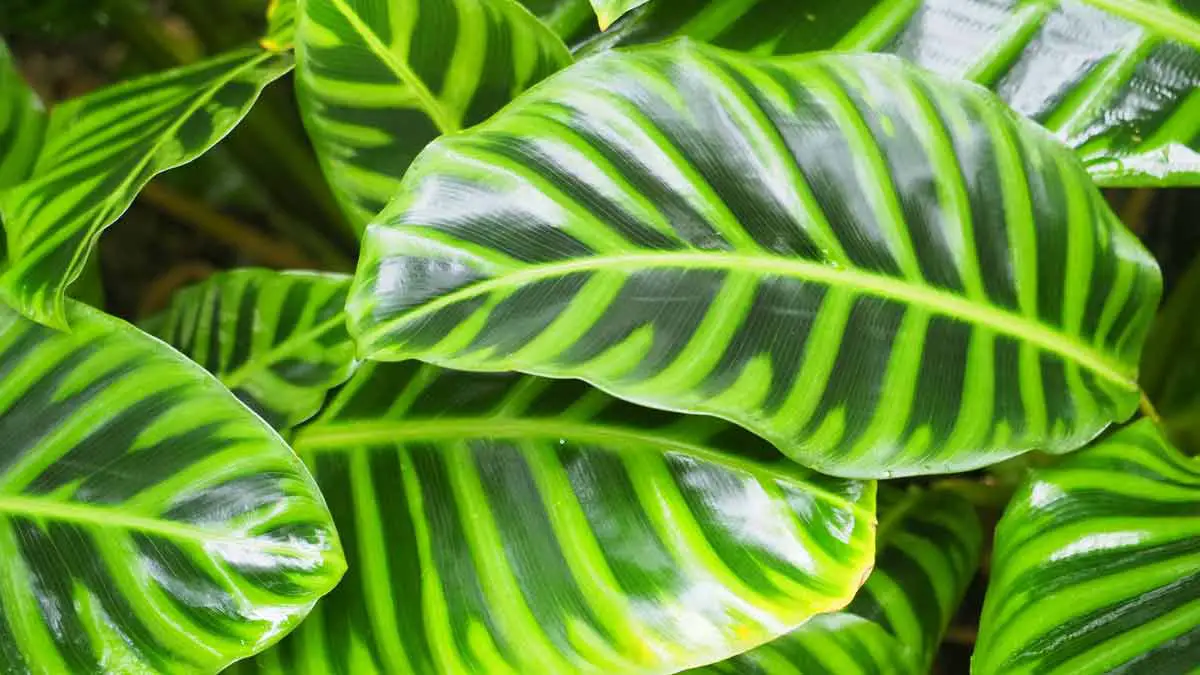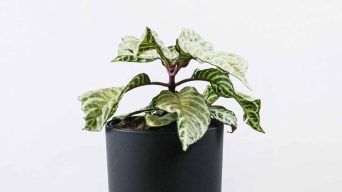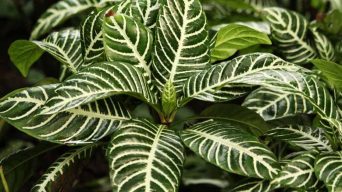Key Takeaways
- Yellowing leaves on zebra plants can be caused by overwatering, underwatering, poor drainage, nutrient deficiency, environmental stress, and pests and diseases.
- To diagnose the cause of yellowing leaves, check the soil moisture levels regularly and inspect for pests or diseases. Evaluate lighting and temperature conditions along with watering and fertilizing regimen.
- Improving drainage with well-draining potting mix and pots with drainage holes can help prevent overwatering while providing balanced fertilizer during the growing season maintains proper nutrients.
- To treat yellowing leaves on your zebra plant, adjust watering habits, remove infected parts, and control pests. Providing adequate light exposure and humidity levels between 40% and 60% help prevents yellow spots or brown tips.
Are you wondering why your zebra plant’s leaves are turning yellow and what can be done to fix it?
Fear not, as this common issue among plant owners is reversible with proper care.
Like many other houseplants, zebra plants require specific conditions for optimal growth and health.
In this blog post, we’ll explore the common reasons behind the yellowing leaves of these eye-catching tropical beauties and provide actionable tips on how to restore their vibrant color.
Common Reasons For Zebra Plant Leaves Turning Yellow
There are several reasons why the leaves of a Zebra plant may turn yellow.
These include overwatering, underwatering, inadequate drainage, lack of nutrients, environmental stress, or infestation by pests and diseases.
Overwatering
Overwatering is a common culprit when zebra plant leaves turn yellow.
Providing your zebra plant with too much water can lead to root rot, which subsequently causes the leaves to lose their vibrant green color and become discolored or yellow.
To determine if overwatering is the cause of yellowing leaves on your zebra plant, carefully inspect its foliage and feel the soil for excess dampness.
If you find collapsed stems or soggy soil long after watering your plant, then overwatering is likely contributing to the problem.
To remedy this situation, remove any affected parts – including decayed roots, damaged leaves, and saturated soil – before repotting your zebra plant in a fresh, well-draining potting mix.
Underwatering
Underwatering is a common culprit behind yellowing leaves on zebra plants.
Depriving your plant of adequate water can lead to dry and wilted leaves, eventually causing them to turn yellow and drop off.
To prevent underwatering, consistently check the soil moisture levels by sticking your finger an inch or two into the potting mix.
If the soil feels dry at this depth, it’s time to give your houseplant a thorough drink.
Set reminders if necessary and be attentive, particularly during warmer months or periods of low humidity when indoor conditions may cause the soil to dry out more quickly than usual.
Poor Drainage
Poor drainage is a common culprit behind yellowing zebra plant leaves, as it can lead to over-saturation of the soil and, ultimately, root rot.
When water cannot drain efficiently from the potting mix, your zebra plant’s roots are forced to sit in stagnant water, deprived of much-needed oxygen.
To improve drainage for your houseplant, start by checking if the pot has suitable drainage holes at its base – this allows excess water to escape instead of pooling around the roots.
Additionally, use a well-draining potting mix explicitly for tropical plants like zebra plants or calathea varieties.
Mixing perlite or bark chips into your existing soil can also help increase its draining capabilities.
Nutrient Deficiency
Inadequate nutrients can also cause yellowing of zebra plant leaves.
A lack of essential minerals such as iron, manganese, zinc, or nitrogen can lead to deficiencies that result in the discoloration of the foliage.
Nitrogen deficiency is a specific nutrient problem that causes leaves to turn yellow and stunt growth.
It’s essential to monitor your plant closely and provide it with a balanced fertilizer during its growing season to prevent nutrient deficiencies from occurring.
Remember not to over-fertilize your zebra plant since this could damage its roots and progressively worsen any pre-existing issues.
Environmental Stress
Environmental stress can cause the yellowing of zebra plant leaves, which can occur due to various factors.
For instance, inadequate sunlight or low humidity levels could lead to the yellowing of leaves.
Similarly, if your watering routine is inappropriate or inconsistent, your zebra plant leaves may start turning brown or yellow as a sign of stress.
When exposed to too much light, the plant can suffer from sunburn that results in yellowing of the leaves.
Pests And Diseases
Zebra plants are susceptible to various pests and diseases that can cause yellowing leaves.
Spider mites, mealybugs, and scale insects can infest the plant and suck its sap, leading to yellow spots on the foliage.
Additionally, bacterial or fungal infections can weaken the plant’s immune system and cause it to experience nutrient deficiencies.
Diagnosing pest or disease problems early on is crucial to prevent them from spreading throughout your zebra plant.
How To Diagnose The Cause Of Yellowing Leaves
If you notice yellowing leaves on your zebra plant, there are several factors you should consider to determine the cause.
Check the soil moisture levels, inspect for pests or diseases, evaluate the lighting and temperature conditions, and analyze the watering and fertilizing routine.
Checking Soil Moisture Levels
Checking the soil moisture levels is essential in diagnosing the cause of yellowing leaves on your zebra plant.
Here are some steps to follow:
- Use your finger or a moisture meter to check the top layer of soil. If it feels dry, it’s time to water your plant.
- Avoid watering your plant if the soil feels damp or wet, which can lead to overwatering and root rot.
- Check the drainage holes at the bottom of your pot to ensure they aren’t clogged, preventing excess water from escaping.
- If you suspect overwatering may be the issue, gently remove your zebra plant from its pot and inspect its roots for signs of rot or damage.
- Adjust your watering routine accordingly based on your findings.
Inspecting For Pests Or Diseases
To ensure that your zebra plant remains healthy and free from pests or diseases, it’s essential to inspect it regularly.
Here are the steps you can take:
- Check both sides of the leaves for any signs of pests such as spider mites, mealybugs, or scale insects.
- Look for visible damage on the leaves, such as holes or chewed areas caused by caterpillars or other insects.
- Examine the soil and surrounding area for any fungal growth or rotting plant matter that may indicate disease.
- Take note of any yellow spots, brown tips, or other discoloration on the leaves that could be a sign of bacterial infections.
- If you notice any signs of pests or disease, isolate the affected plant immediately to prevent further spread to your other plants.
Always wash your hands and tools before handling different plants to avoid cross-contamination.
Evaluating Lighting And Temperature Conditions
Proper lighting and temperature conditions are essential for a healthy zebra plant.
Here are some factors to consider when evaluating lighting and temperature conditions:
- Bright indirect light: Zebra plants prefer moderate to bright indirect light, but direct sunlight should be avoided as it can scorch the leaves.
- Avoid complete shade: Zebra plants need some exposure to light to bloom, so ensure they receive adequate light by placing them near a north or east-facing window.
- Temperature: Zebra plants thrive in temperatures ranging from 65°F to 75°F (18°C to 24°C) during the day and 60°F to 65°F (15°C to 18°C) at night. Ensure the temperature does not drop below their minimum threshold of 55°F (13°C).
- Humidity: These tropical plants require humidity levels between 40% and 60%, which can be maintained by using a humidifier or placing a water tray near the plant.
By evaluating lighting and temperature conditions, you can ensure your zebra plant receives the ideal growing environment necessary for its health and growth.
Evaluating Watering And Fertilizing Regimen
One of the common reasons for yellowing leaves in zebra plants is inappropriate watering and fertilizing routines.
To evaluate and adjust those routines, consider the following steps:
- Regularly check the soil moisture levels using a moisture meter or stick your finger into the soil up to the second knuckle. If the soil feels damp, wait until it dries out before watering again. Overwatering can lead to waterlogging and cause root rot.
- Use a well-draining potting mix with adequate drainage holes to prevent water from accumulating at the bottom. Ensure that excess water drains away promptly after watering.
- Water your zebra plant thoroughly, ensuring the entire root ball gets saturated, but avoid leaving standing water on top of the soil.
- Fertilize your zebra plant with a balanced fertilizer once every two to three weeks during its growing season (spring and summer). Follow the instructions on the package regarding dosage and application method.
- Avoid overfertilizing your zebra plant, as this can lead to salt buildup in the soil and damage its roots.
Treating Yellowing Leaves On A Zebra Plant
If you notice yellowing leaves on your zebra plant, you can take some steps to address the issue.
You must adjust your watering habits by allowing the soil to dry out between waterings and using a well-draining potting mix and pots with drainage holes.
You should also remove infected leaves and use insecticidal soap or neem oil to control pests.
Additionally, provide the plant with a balanced fertilizer and move it to a more suitable location with adequate lighting and temperature.
Adjusting Watering Habits
Adjusting watering habits to treat yellowing leaves on your Zebra plant is essential.
Here are some tips to help you get started:
- Check the soil moisture level regularly and water only when the top inch of the soil feels dry to the touch.
- Avoid overwatering by ensuring adequate drainage in the pot and using a well-draining potting mix.
- Water deeply but infrequently, allowing excess water to drain away completely.
- Consider using a moisture meter to help determine when your plant needs watering.
- If you have been overwatering your Zebra plant, give it time to recover by reducing watering frequency and allowing the soil to dry out slightly between waterings.
- On the other hand, if you have been underwatering your Zebra plant, increase watering frequency gradually until the soil remains consistently moist but not waterlogged.
Remember that adjusting watering habits can take some trial and error, so be patient and observant as you make changes.
In time, you should see an improvement in your Zebra plant’s leaf color and overall health.
Improving Drainage
Improving drainage is crucial in treating yellowing leaves on a zebra plant.
Here are some steps to take:
- Choose a well-draining potting mix that allows for proper water movement.
- Ensure your pot has drainage holes and is not sitting in standing water.
- Add coarse sand or perlite to the soil mix, ensuring adequate drainage for the roots.
- Avoid overwatering as it can lead to root rot and other issues related to poor drainage.
- Repot your zebra plant into a container with better drainage if necessary.
By improving drainage, you can prevent water stress on your zebra plant and help it thrive in its environment.
Check soil moisture levels regularly and adjust watering habits to prevent over or under-watering.
Providing Proper Nutrients
To help prevent yellowing leaves on your zebra plant, it’s important to provide proper nutrients.
Here are some tips to ensure your plant is getting the right amount of nutrients:
- Use a balanced fertilizer: Choose a balanced fertilizer that contains equal amounts of nitrogen, phosphorus, and potassium. This will help promote healthy growth and prevent nutrient deficiencies.
- Fertilize regularly: During the growing season, fertilize your zebra plant every 2-3 weeks with a diluted balanced fertilizer solution.
- Provide micronutrients: Zebra plants also require iron, magnesium, and calcium. These can be provided through supplements or potting soil containing these nutrients.
- Avoid over-fertilizing: Too much fertilizer can cause harm to your plant and lead to the burning of roots or foliage. Make sure to follow the instructions on the label and don’t exceed the recommended dosage.
Providing proper nutrients for your zebra plant helps ensure its overall health and prevents yellowing leaves caused by nutrient deficiencies.
Removing Infected Leaves
Removing any infected or yellow leaves is necessary to prevent further damage to your zebra plant.
Here are some tips on how to safely and effectively remove these leaves:
- Use clean scissors or pruning shears to cut the affected leaves as close to the base of the plant as possible.
- Do not tear or rip off the leaves, as this can damage the healthy foliage and potentially spread infection.
- Dispose of the removed leaves in a separate container away from your other plants.
- Disinfect your tools after each use with rubbing alcohol or a bleach solution.
- Keep an eye out for any new signs of yellowing or infection, as prompt action can prevent further damage.
Pest Control
Pests and diseases can cause the yellowing of leaves on Zebra plants. Here are some pest control methods to fix the problem:
- Identify the type of pests and use appropriate insecticides or neem oil to eliminate them
- Quarantine the plant and treat nearby plants to prevent the spreading of pests
- For mealybugs or spider mites, use a cotton swab dipped in alcohol to remove them from the underside of leaves
- Avoid over-fertilizing as it can attract pests
- Use sticky traps near the plant to catch flying pests
- Remove any damaged or dead plant material regularly, as it may attract pests
Remember, preventing pest infestations is better than having to control them. Always check new plants for pests before bringing them indoors.
Moving The Plant To A More Suitable Location
If you notice yellowing leaves on your zebra plant, it may be time to move it to a more suitable location.
Here are some tips for finding the right spot:
- Provide adequate sunlight – Zebra plants thrive in bright, indirect light. Move the plant to an area that receives bright, indirect sunlight for at least 6 hours daily.
- Avoid direct sunlight – Direct sunlight can scorch the leaves of a zebra plant, so avoid placing it in a south-facing window or another spot where it will receive too much direct sun.
- Consider temperature – Zebra plants prefer temperatures between 60-75 degrees Fahrenheit, so avoid placing them near heaters or air conditioning vents.
- Increase humidity – If the air in your home is dry, consider moving your zebra plant to a more humid location. You can also increase humidity by placing a water tray near the plant or using a humidifier.
- Check for drafts – Too much airflow can cause stress and damage to zebra plants, so ensure they are not placed near drafty windows or doors.
Remember that every plant is unique and may have slightly different needs when it comes to light and temperature preferences.
Observe your zebra plant closely and adjust its location based on how it responds to its environment.
Proper Pruning
Proper pruning is crucial in treating yellowing leaves on a zebra plant.
Clean scissors or shears should always be used when pruning to reduce the chance of infection.
Here are some steps to follow when pruning a zebra plant:
- Identify the yellowing or dying leaves that need to be removed.
- Use clean and sharp scissors or shears to make clean cuts just above the plant’s base.
- Prune stems and leaves back to a pair of leaves at the base of the plant, as this can encourage new growth.
- Remove any dead or damaged stems or branches, cutting them back to the main stem if necessary.
- Don’t prune more than one-third of the zebra plant at any one time, as this can cause shock and stress for the plant.
Remember that leaves that have turned yellow will never be green again and can be removed.
Removing yellow or dying leaves and plant debris can encourage better growing conditions for your zebra plant by reducing the risk of disease and pest infestations.
Tips For Preventing Yellow Leaves On Zebra Plants
- Water your zebra plant properly, ensuring the soil is moist but not waterlogged.
- Use a well-draining potting mix and ensure there are drainage holes in the pot.
- Provide your plant with adequate lighting, placing it in a bright, indirect light source or near a west-facing window.
- Fertilize regularly with a balanced fertilizer to prevent nutrient deficiencies.
- Keep pests at bay by inspecting regularly and using insecticidal soap if necessary.
Proper Watering
Watering is an essential aspect of keeping your zebra plant healthy.
Here are some important tips to ensure proper watering:
- Water your zebra plant thoroughly, but allow the soil to drain completely before replacing it in its saucer.
- Avoid overwatering as it can lead to root rot and yellow leaves.
- Zebra plants prefer consistently moist soil, so regularly check the soil’s moisture level.
- Watering frequency depends on the season, humidity level, and pot size. Water less frequently during winter months or when the humidity is low.
- Avoid getting water directly on the leaves as it can cause crown rot and yellow spots on the foliage.
Adequate Drainage
Zebra plants are sensitive to overwatering and poorly draining soil.
Adequate drainage is crucial for maintaining healthy zebra plants.
Here’s what you should do:
- Ensure your pot has drainage holes: If there are no drainage holes, the water will stagnate in the soil, leading to root rot and yellowing leaves.
- Use well-draining potting mix: A well-draining potting mix helps excess water drain away from the roots quickly.
- Improve drainage: If your plant’s soil retains too much moisture, add perlite or sand to improve drainage.
- Don’t let your plant sit in standing water: Empty any excess water from the saucer below the pot after watering.
Ensuring adequate drainage for your zebra plant can prevent root rot and yellowing leaves caused by overwatering.
Proper Lighting And Temperature
Ensuring proper lighting and temperature is essential to keep your zebra plant healthy.
Here are a few tips to take care of lighting and temperature:
- Provide bright, indirect sunlight: Zebra plants thrive in bright, indirect light, so place them near a north or east-facing window.
- Avoid direct sunlight: Direct sunlight can cause the leaves to burn and turn yellow quickly. If you must put it in direct sunlight, do so for only a short period.
- Ensure adequate warmth: Zebra plants prefer temperatures between 65-80 degrees Fahrenheit during the day and cooler temperatures at night.
- Protect from cold drafts: Ensure your zebra plant isn’t exposed to cold drafts or sudden temperature changes, which can damage the leaves.
- Use grow lights if necessary: If you cannot provide adequate light through natural sources, consider using full-spectrum grow lights for at least 12 hours daily.
Regular Fertilization
Proper fertilization can go a long way in preventing yellowing leaves on your zebra plant.
Here are some tips to keep in mind when fertilizing:
- Use a balanced fertilizer: Look for a fertilizer with an equal nitrogen, phosphorus, and potassium (NPK) ratio. This will provide your plant with the necessary nutrients for healthy growth.
- Follow package instructions: Over-fertilizing can be just as harmful as under-fertilizing, so follow the instructions on the packaging carefully.
- Fertilize during the growing season: Zebra plants typically grow during the spring and summer months, so it’s best to fertilize during this time to support their growth.
- Dilute fertilizer before use: Mix your fertilizer with water according to the package instructions and apply it to damp soil.
- Avoid direct contact with leaves: Fertilizer can burn your plant’s leaves if it comes into direct contact with them, so aim to apply it directly to the soil around the base of the plant.
Pest Prevention
One of the key factors in preventing yellowing leaves on your zebra plant is taking steps to control pests.
Here are some tips for keeping insects and other pests at bay:
- Regularly inspect the plant for signs of infestation, such as webs, small holes, or sticky residue on leaves.
- Keep the plant clean and free of debris that may harbor insects.
- Use natural remedies like neem oil or insecticidal soap to treat any infestations.
- Quarantine new plants before introducing them to your zebra plant to prevent transferring pests.
- Avoid over-fertilizing, which can attract pests and weaken the plant’s natural defenses.
Remember, prevention is always better than cure regarding pest control.
By watching and taking action early, you can keep your zebra plant healthy and thriving.
Proper Pruning
Proper pruning is crucial in maintaining the health and appearance of your Zebra plant.
Here are some essential steps to follow:
- Remove yellow or dying leaves: This will help prevent diseases from spreading to other parts of the plant.
- Cut at an angle: Use clean, sharp scissors or shears to make a clean cut at a 45-degree angle, promoting faster healing.
- Trim leggy stems: If your Zebra plant is stretching and getting leggy, prune it back by cutting one-third of the stem’s length.
- Prune after flowering: Once your Zebra plant finishes flowering, prune it back to encourage new growth.
- Don’t over-prune: Only remove what is necessary and avoid over-pruning as it can stress the plant and cause more harm than good.
Final Thoughts
Yellowing leaves on your zebra plant can indicate problems such as overwatering, underwatering, poor drainage, and environmental stress.
However, diagnosing the issue is the first step towards treating it effectively.
You can bring back your plant’s health by adjusting your watering habits, improving drainage, providing proper nutrients, and removing infected leaves or pests and diseases.
Remember to take preventative measures such as ensuring adequate lighting, temperature conditions, and regular fertilization to keep your zebra plants thriving.







